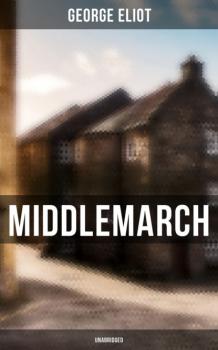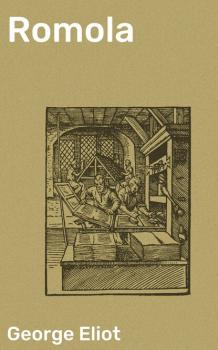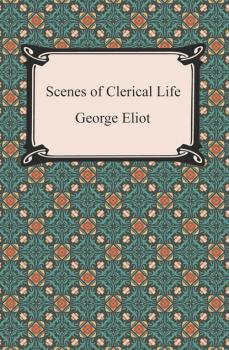George Eliot
Список книг автора George EliotEl velo alzado
Latimer es un joven frágil y enfermizo, con la sensibilidad del poeta: inútil para toda actividad utilitaria que pudiera hacerle ocupar un lugar en la sociedad, pero despierto a la belleza del arte y la naturaleza. Sería el prototipo del héroe romántico, si no fuera porque Latimer es un poeta mudo […] Tras el embate de una enfermedad indefinida se descubre poseedor del don de la clarividencia. La clarividencia de Latimer es una inusual incursión de Eliot en el terreno del romanticismo y el gótico, por no hablar de la resucitación de una muerta –la oscura señora Archer–, mediante una transfusión. Como en Frankenstein, que lo precede y que probablemente Eliot haya leído, aquí también la ciencia, y la ambición intelectual que la acucia, se presentan como un peligroso catalizador de la desgracia.
The Mill on the Floss
"The Mill on the Floss" by George Eliot. Published by Good Press. Good Press publishes a wide range of titles that encompasses every genre. From well-known classics & literary fiction and non-fiction to forgotten−or yet undiscovered gems−of world literature, we issue the books that need to be read. Each Good Press edition has been meticulously edited and formatted to boost readability for all e-readers and devices. Our goal is to produce eBooks that are user-friendly and accessible to everyone in a high-quality digital format.
Middlemarch (Unabridged)
This eBook has been formatted to the highest digital standards and adjusted for readability on all devices. Middlemarch, A Study of Provincial Life is centered on the lives of the residents of Middlemarch, a fictitious Midlands town, from 1829 onwards—the years preceding the 1832 Reform Act. The narrative is variably considered to consist of three or four plots of unequal emphasis: the life of Dorothea Brooke; the career of Tertius Lydgate; the courtship of Mary Garth by Fred Vincy; and the disgrace of Nicholas Bulstrode. Significant themes include the status of women, the nature of marriage, idealism, self-interest, religion, hypocrisy, political reform, and education.
The Lifted Veil and Brother Jacob
George Eliot, the pen named used by Mary Anne Evans, wrote popular works that epitomized the settings and ideology of contemporary Victorian England. She was brought up in the Church of England, where she developed strong moral convictions that carried over into her fiction; she often presented stories of social outsiders and small-town persecution. When «Brother Jacob» was completed in 1864, it was published together with «The Lifted Veil» (1859) as a companion piece. «The Lifted Veil» is a dark fantasy about a young artist with clairvoyant abilities, and explores the science of the brain, mesmerism, phrenology, as well as themes of fate, and the mysteries of life and life after death. «Brother Jacob», a satirical modern fable, tells the story of a spiteful young man who is unsatisfied with his station in life. He struggles with an idiot brother, and a literal and symbolic conflict with sugar.
Scenes of Clerical Life
George Eliot, the pen name used by Mary Anne Evans, wrote popular works that epitomized the settings and ideology of contemporary Victorian England. She was brought up in a large farmhouse near Coventry, where she was surrounded by the wide fields, large trees, canals and small roads that would color the landscape of her later fiction. Evans was raised in the Church of England, where she developed strong moral convictions that carried over into her fiction; she often presented stories of social outsiders and small-town persecution. Her first published work of fiction, «Scenes of Clerical Life», includes «The Sad Fortunes of the Reverend Amos Barton,» which was first published in Blackwood's Magazine to great review. Each of the three stories in this book take place in and around the fictional town of Milby, and examine the effects of religious reform, the clergy, and social issues like poverty, alcoholism and domestic violence.
Adam Bede
Originally published in 1859, “Adam Bede” is the first novel by George Eliot, which was the pen name of Mary Ann Evans. Eliot was one of the leading British writers of the Victorian era, as well as a noted journalist, poet, and translator. “Adam Bede” concerns a small, tight-knit, and fictional rural community called Hayslope and the romantic drama that develops between four of its young residents: the title character Adam, a young carpenter, the beautiful young Hetty Sorrel, Captain Arthur Donnithorne, a young squire, and Hetty’s cousin, the virtuous Methodist lay preacher, Dinah Morris. Adam, respected for his intelligence and integrity, has fallen in love with Hetty, who in turn has fallen in love with Arthur, the local squire’s charismatic grandson and heir. Adam discovers that Hetty and Arthur have been meeting in secret and uses this knowledge to force his rival to leave town. However, before Hetty and Adam can wed, Hetty discovers herself to be pregnant and a series of bad decisions results in tragic consequences. A classic of 19th century literature, “Adam Bede”, a popular choice in English literature courses, remains a classic tale of love, desperation, and redemption. This edition includes a biographical afterword.
The Mill on the Floss
First published in 1860, George Eliot’s “The Mill on the Floss” tells the story of Tom and Maggie Tulliver, a brother and sister growing up on the fictional river Floss near the village of St. Oggs in Lincolnshire, England. Set in the early 1800s over a period of several years, the novel follows the two main characters from childhood to young adulthood. Maggie and Tom’s love and loyalty to each other is the primary relationship of the novel, as well as Maggie’s connections to the two young suitors she is often torn between. Maggie struggles to decide if she will violate the social code of her time and risk ostracism from her family and friends to follow her own passions and desires. It is a struggle that women from many time periods can relate to. While Tom is stubborn and traditional, Maggie is often caught between what she should do and what she wants to do. This deeply personal and tragic tale remains a popular and enduring example of George Eliot’s importance in English literature. This edition includes a biographical afterword.









